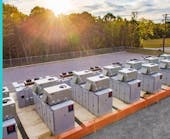Tariff Threats: Energy Storage Prices Could Rise 35% or More in Trade War
Battery storage capacity has skyrocketed in the U.S. as energy transition developers seek balancing assets for renewables, but the near-term pricing dynamic may face increasing pressure on the political horizon.
If steeper tariffs are enacted on the global battery energy storage supply chain under the Trump Administration, the near-term impact could raise U.S. costs on battery technology by 35% or more, according to a new report by the group Clean Energy Associates. Whether this impedes that multi-year growth pattern remains to be seen.
The rising costs could prove even higher for the Chinese-based materials such as direct current (DC) blocks, the report forecasts. The Clean Energy Associates (CEA) study used a base case of Section 301 tariffs increased to 60% on these imported battery energy storage technologies.
“Regardless of the level of exposure, tariff-inclusive BESS prices will be above the typical prices in 2023 in the base case,” reads the executive summary of the CEA’s ESS Price Forecasting report. “While there is the possibility for lower Section 301 rates, there is also a potential for even higher tariff rates given additional avenues of trade law being pursued.”
President-elect Trump has threatened higher tariffs on foreign markets even when what has been enacted under both President Biden and the previous Trump administration. Section 301 is the tariff authorization part of the U.S. Trade Act of 1974.
Recent data reported by the National Renewable Energy Laboratory indicated that costs for battery storage averaged $477 per kWh for a 240-MWh system. The U.S. Energy Information Administration estimated that energy storage installed capacity nearly doubled last year with more than 15 GW in projects installed.
Reshoring the Rare Earth and Critical Elements Supply Chain
China currently dominates the global supply chain for lithium-ion battery technologies with a 70 to 90 percent share of the market, according to the Carnegie Endowment for World Peace website. The U.S. ranks fourth in world market share for lithium-ion, the foundation of chemistry which accounts for a sizable majority of electric vehicle and energy storage systems.
To that end, last month the U.S. Department of Energy recently awarded investments totalling $17 million for 14 projects nationwide focused on improving the domestic supply for rare earth and critical materials in the battery storage and electrification supply chain. Among the recipients were research and development projects at Texas A&M, North Dakota University, ABB, Summit Nanotech and Ames National Laboratory, among others.
The U.S. is also working on potential lithium mines inside the country, including projects in Nevada and Tennessee.
Fortunately, the CEA report noted, lithium prices fell 69%, on average, from 2023 to 2024. The three-year outlook envisions only a slight, steady rise in lithium-ion market prices regardless of the tariff issue.
Seeking sourcing diversity also can help drive basic battery cost reductions, the CEA summary noted. The U.S. lately has worked to tighten the battery technology supply chain, both by bringing manufacturing home or seeking contracts elsewhere in Asia, Australia and North America.
From NA+ to Volanic Geothermal and Nuclear Fusion
Check out our EnergyTech E-Book on Innovations to Net Zero





